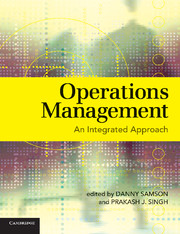Book contents
- Frontmatter
- Contents
- List of Contributors
- Preface
- Acknowledgements
- Part I Operations within Organisations – Building Blocks
- Part II Approaches to Understanding OM
- Part III Moving Forward with OM – Creating Competitive Advantage
- Part IV Challenges and Opportunities in Operations
- Part V Case Studies
- 1 Innovation in the Biotechnology Sector: The Case of IDT Australia
- 2 New Zealand King Salmon: Value-Chain Innovation
- 3 Pilila Clothing Company Goes Lean
- 4 From Singapore to the World: Port Management in Singapore
- 5 Striving for Operations Excellence within Queensland Rail Supply Division
- 6 Should I Stay or Should I Go? Shiraishi Garments Company
- 7 Towards a Green Supply Chain: Toyota Australia
- 8 Process Analyses and Improvement at Bartter Enterprises
- 9 Operations Challenges at Firth Industries Limited, Wellington Division
- 10 Ford Motor Company: Moving Forward in Australia
- 11 Technology Transfer at Hero Honda
- 12 Why Is the Patient Resident Time so Long?: The Case of St Martin's and Charity Private Hospital
- Index
7 - Towards a Green Supply Chain: Toyota Australia
Published online by Cambridge University Press: 05 June 2012
- Frontmatter
- Contents
- List of Contributors
- Preface
- Acknowledgements
- Part I Operations within Organisations – Building Blocks
- Part II Approaches to Understanding OM
- Part III Moving Forward with OM – Creating Competitive Advantage
- Part IV Challenges and Opportunities in Operations
- Part V Case Studies
- 1 Innovation in the Biotechnology Sector: The Case of IDT Australia
- 2 New Zealand King Salmon: Value-Chain Innovation
- 3 Pilila Clothing Company Goes Lean
- 4 From Singapore to the World: Port Management in Singapore
- 5 Striving for Operations Excellence within Queensland Rail Supply Division
- 6 Should I Stay or Should I Go? Shiraishi Garments Company
- 7 Towards a Green Supply Chain: Toyota Australia
- 8 Process Analyses and Improvement at Bartter Enterprises
- 9 Operations Challenges at Firth Industries Limited, Wellington Division
- 10 Ford Motor Company: Moving Forward in Australia
- 11 Technology Transfer at Hero Honda
- 12 Why Is the Patient Resident Time so Long?: The Case of St Martin's and Charity Private Hospital
- Index
Summary
Introduction
Attaining environmental excellence through operations is a well established element of many successful production systems. Organisations have learnt much from establishing a connection between improving processes and operational efficiency and the subsequent benefits in environmental performance. Greener operations management provides benefits to the firm such as waste reduction, improved processes, fewer quality issues, less packaging, removal of toxic materials and environmentally sound innovations to name a few.
Combining environmental performance goals with the goals of the operations function has been borne out as providing a legitimate competitive advantage for the modern corporation. Manufacturers that are able to reduce pollution or waste in-process, avoid the costly re-management of wastes or having to invest in pollution control technology. Thoughtful consideration of environmental goals at the operations level has also led to successful new product innovation examples such as the recyclable disposable camera (Kodak), a 100 per cent recyclability of the automobile (BMW), and the use of hybrid technology to reduce fuel consumption (the Toyota Prius).
As raw material costs increase and environmental protection legislation becomes increasingly stringent, a focus on green operational excellence is becoming the norm in organisations. To attain even greater cost savings from waste reduction, meet comprehensive social and environmental responsibility targets and find new products with smaller ecological footprints, firms are now extending their goals for environmental performance into their suppliers' operations. This type of activity is known as ‘green-supply’ and is an effective mechanism for firms to improve their record on corporate social responsibility, lower reputational risks, reduce wastes and improve supply chain response-time to new environmental regulations.
- Type
- Chapter
- Information
- Operations ManagementAn Integrated Approach, pp. 483 - 489Publisher: Cambridge University PressPrint publication year: 2008

